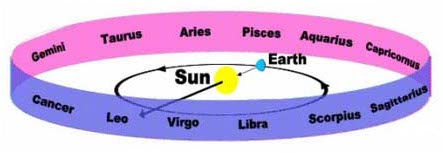
by John P. Pratt
9 Jul 2016, 1 Quake (SR), 1 Birth (V), Passover (UE), Pollux (S)
©2016 by John P. Pratt. All rights Reserved.
| 1. The Star Calendar |
| 1.1 Aligned with Week |
| 1.2 Holy Days |
| 1.3 Uniform Version |
| 2. The Prophet Joseph Smith |
| 2.1 Constellations and Mythology |
| 2.2 Birth Date |
| 2.3 Death Date |
| 2.4 Family Dates |
| 3. Life of Jesus Christ |
| 3.1 Birth Date |
| 3.2 Resurrection Date |
| 3.3 Other Events |
| 4. Biblical Events |
| 4.1 Patriarchs |
| 4.2 Jacob's Family |
| 4.3 Exodus |
| 5. LDS Events |
| 5.1 First Vision |
| 5.2 Priesthood Restoration |
| 5.3 Public Ministy |
| 5.4 Kirtland Temple |
| 6. Conclusion |
| Notes |
In earlier articles many different sacred calendars have been presented, all of which are evidently being used by the Lord to determine "holy days" on which His sacred events occur. The Book of Enoch states that certain stars represent the Lord's faithful servants. The Enoch Calendar has 364 days and that book states that there are 364 servants each represented by a star (Enoch 43:1-2, Enoch 81:15). That implies that there could be a "Star Calendar" to associate every day of the year with a star and that star representing one of the Lord's servants. That possibility led to the discovery of the Star Calendar described in this article.[1] Let us now look at just how the Star Calendar works. Those who wish to avoid a technical overview can skip Section 1. All that is really needed to understand is that every day of the year is associated with a star derived from that star's actual position in the heavens. If you don't wish to read the entire article, you can get most of the ideas from the illustrations.
 |
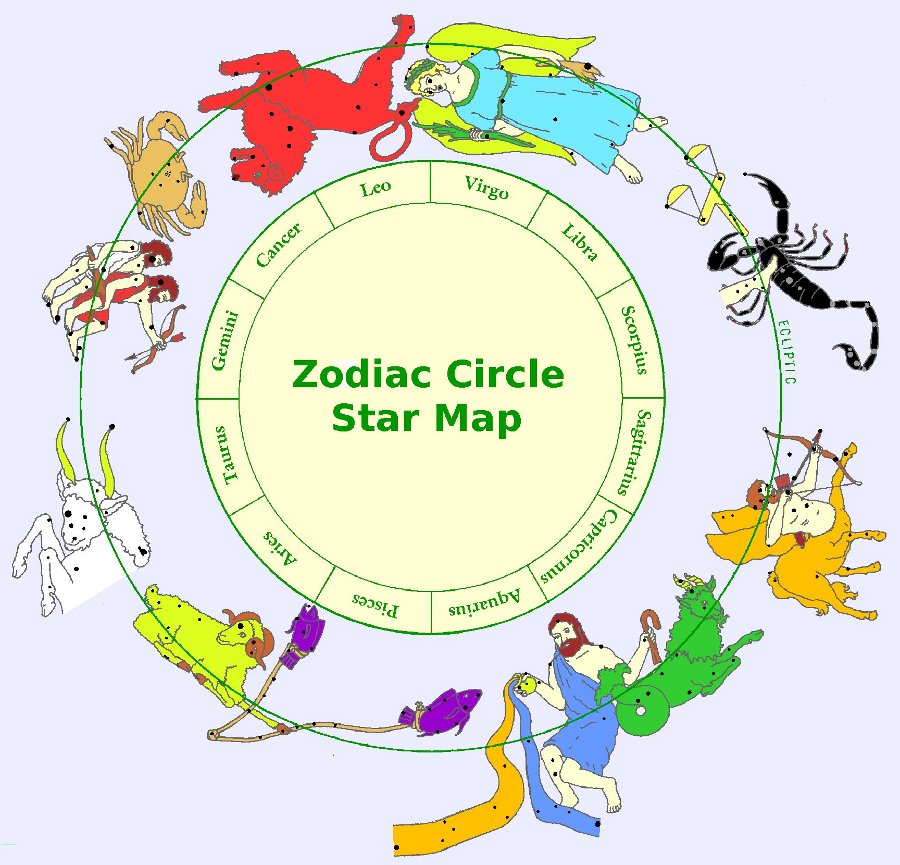 |
As also shown in Figure 2, the circle of stars through which the sun appears to move clockwise every year is called the zodiac. It is divided into twelve constellations. Some of the zodiac constellations are much bigger than others. The constellation of the Crab (Cancer) only spans about two weeks of sky, whereas the Maiden (Virgo) requires about six weeks for the sun to appear to traverse. Let us now see how the stars are associated with days of the year. Keep in mind that this calendar is a work in progress. Some details may be subject to change and only a few star identifications are now firm enough to publish. The basic framework now seems to be in place but there is much fleshing out of details left to be finished.
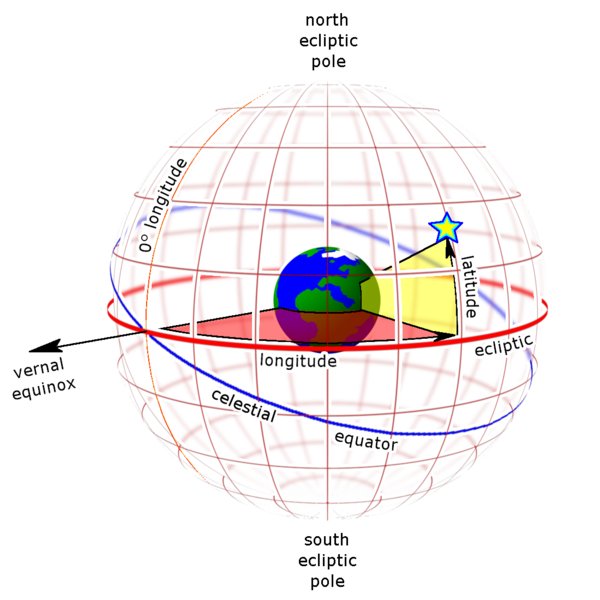 |
Constellations are allowed to overlap each other, or have gaps between them, just as do the actual figures in the heavens. Each zodiac constellation begins on a Saturday, but it might not end on a Friday if there is a gap between it and the next one. In the case of overlapping, each day is assigned either to one constellation or the other. The order is the same as in the zodiac circle shown in Figure 2: the first is the Maiden (Virgo) and the last is the Lion (Leo). The days are numbered according to the constellation: 1 Vir, 2 Vir, 3 Vir, ... 42 Vir, 1 Lib, 2 Lib, etc. Each day is also associated with a star. When the extra week is added to keep aligned with the true positions of the sun relative to the stars, it is added at the end of the Lion.[2]
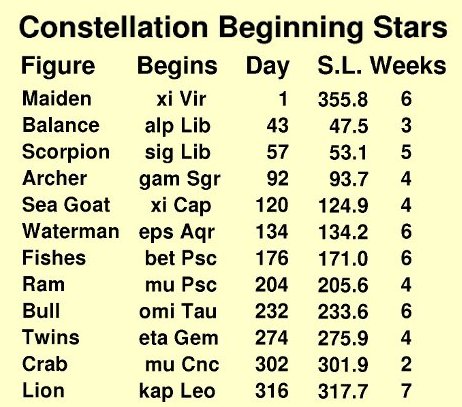 |
How are stars assigned to days? The circle in the sky around the earth on which the sun appears to move is called the ecliptic. It is shown in Figure 2 as the circle going through all of the zodiac constellations. Every star in the heavens can be assigned to a day by projecting an arc down from it perpendicular to the ecliptic. Each star is assigned a "celestial longitude", which is the length of the arc in degrees measured from a starting point, much like longitude on the earth is measured (see Figure 3). In this article and for the purposes of the Star Calendar, the longitude is measured from a zero point in the head of the Maiden (Virgo) and is called "sidereal longitude". In Figure 2, the sidereal longitude of any star on the map is simply the arc in degrees clockwise to the star starting from the "12 o'clock" line (between the labels of Leo and Virgo). The day on which the sun passes that point can be associated with that star. If the day falls on the same day as another star, one of them can be moved a day or so to fit into a nearby available slot.
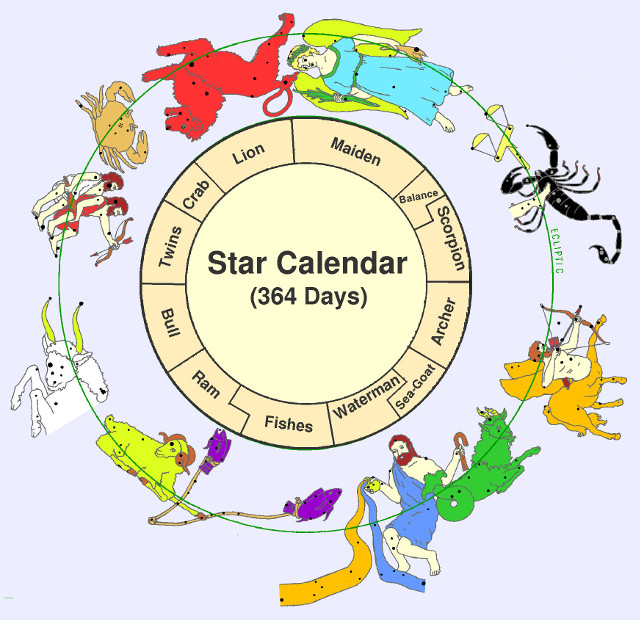 |
Minor holy days include the "lunar mansions" which are markers all around the zodiac roughly equally spaced to be the distance that the moon appears to move in a day. Also there is often a single star chosen to represent an entire constellation. Sometimes it is found in the head and sometimes it is the brightest star in the figure. In the tables, minor holy days are shown in blue. Normal days are shown in black.
All of the bright stars are associated with Christ in one way or another, and all such in the original 48 constellations are considered holy. Because all of the stars are to represent holy men, no stars from the 6 constellations which represent evil forces were included. Those excluded constellations are Draco, Hydra, Cetus, Eridanus, Lepus and Ara.
The Enoch Calendar has two versions, as do all of the planetary calendars. One version tracts the actual average position of the object through the heavens. The second does not; it never adds any extra days to actually follow the object of interest but always has the same number of days. It is called the "Uniform" version. There is also a Uniform Star Calendar which always has exactly 364 days, the same as the Uniform Enoch Calendar. The use of this calendar is that it can provide information about an event independent of the time of year it occurs. One day in history is chosen to align this calendar with a known event. Because there are never any extra days inserted, every date in history is determined once that single date is selected.
Thus, the Uniform Enoch and Uniform Star calendars are always aligned with each other the same every year. If a certain star on the Uniform Star Calendar falls any given day on the Uniform Enoch Calendar, it will always fall on that day every year. The day chosen for the two to align is that 1 Summer (UE) always falls on 1 Leo (US). That was chosen both because that was the day of the Beginning of Mortality when Adam and Eve left the Garden of Eden (from which our time is reckoned) and it seems logical because both of those days begin a quarter of the year. Even though the Uniform Star Calendar adds more witnesses of many sacred events, it is not discussed much further in this article because it seemed complicated enough just to introduce one star calendar.[4]
Let us now begin seeing the witness of the Star Calendar by considering its testimony of the Prophet Joseph Smith. That is the most powerful for two reasons. First, much more is known about his life and that of his family. Second, the precise dates are known from history rather than from calculations about the ancient past. As explained above, stars are assigned to days of the year according to their sidereal longitudes. To avoid unnecessary detail, those longitudes are not all presented in this article. They can be found in my published star tables.[5]
In my earlier articles, evidence was presented which compelled me to propose that the Prophet Joseph Smith should be included in the list of the seven chief holy angels of God, along with other spiritual giants including Adam, Enoch, Noah and Moses.[6] Additional further evidence is here added to confirm that conclusion. Before presenting it, let us review some of that evidence from the stars and the myths concerning them. It is important to understand that the Book of Enoch claims that an angel revealed the sacred figures of the constellations to the Prophet Enoch. They were considered holy by many ancient nations. It is likely that some of the accompanying myths could also date back to Enoch. Both the stories and the figures could have been corrupted, so many of my articles have attempted to restore the figures to their original form.[7] Let us now turn to some constellations and myths which clearly seem to refer to the Prophet Joseph Smith.
 |
Afterward, while flying home with the monster's head in hand, Perseus saw the beautiful princess Andromeda chained to a cliff as an offering to the Sea Monster. After first getting assurance that he can marry her if he saves her, he destroyed that monster and marries the princess bride. Thus, there seem to be two main roles of Perseus. He is a hero and a bridegroom. The English name for Perseus in my work is "Hero" as it describes his principal role, but "Bridegroom" is a close second.
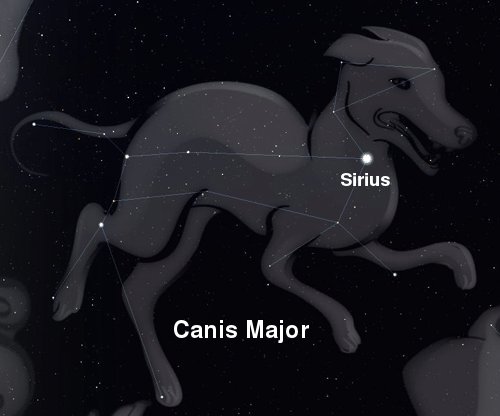 |
Three other constellations were also shown in that same article to refer to that same quest. It was suggested that the Hunter (Orion), the brightest constellation in the heavens, represents Adam. He has two hunting dogs, the Big Dog (Canis Major) representing Joseph Smith and the Little Dog (Canis Minor) representing Abel. They are chasing the Hare (Lepus), who it was suggested represents the wicked adulterous female. These figures give further insight into the myth of Perseus. In particular, it shows that Joseph is working under the direction of Adam and with the help of Abel.
Another constellation shows two men who are brothers. The Twins (Gemini) are named Castor and Pollux in myths. Pollux was a champion wrestler (or boxer) just as was Joseph Smith. Also in that article Pollux was identified with Joseph Smith and Castor with Abel.
Thus, it appears that several constellations refer directly to Joseph Smith. Joseph of Egypt prophesied of his descendant who would be a great seer, who would rank with Moses (2 Nephi 3:17-18).
Now let us turn to the new confirming evidence that these interpretations are correct, because the birth and dates of these men are "written in the stars".
The date on the Star Calendar for the birth of the Prophet Joseph is 10 Sgr. That corresponds to a star in the bow of the Archer (Sagittarius). With so many constellations available representing him, the birth date seemed surprising at first.
The blessings given to his twelve sons by Jacob have many references to constellations in them. Reuben is called unstable as water (Waterbearer), Dan is a serpent which bites heels (Scorpion) and Judah is a Lion. In the later blessing by Moses, Joseph is referred to as a wild ox (the Bull, mistranslated "unicorn" in KJV), with his two sons Ephraim and Manasseh being the two horns (Deut. 33:17).
What was Jacob's blessing to Joseph? Here is part of it:
But his bow abode in strength, and the arms of his hands were made strong by the hands of the mighty God of Jacob (Gen. 49:24)
We know a lot of detail about the life of Joseph of Egypt. Having his bow be strong does not sound like a highlight of his life. It might refer to his descendants being mighty warriors. But it is well known that many of these blessings have obscure and/or multiple meanings. Consider the possibility that another intended meaning of this blessing could be a reference to the Prophet Joseph Smith being the "bow". If so, then the word "his" in "arms of his hands" could refer to the strength of Joseph Smith. He was known for his great strength, which allowed him to become a champion wrestler.
In any case, it seems possible that Joseph Smith could indeed be symbolized by the Bow of the Archer. If so, then Joseph was born on a day representing him. That star is called the "Bow" in my work now. The day proposed in my work for the date of the death of Isaac was also on the day of the Bow, so Joseph is in good company.
.jpg) |
There is also a second witness. In my work the name of the day of the Hebrew Calendar (10 Tammuz) on which the Prophet Joseph Smith was murdered has been called "Raven Day" because it was the same day as Noah released the raven from the ark. Moreover, it was suggested that it should be considered a holy day because it completes the set of four fast days of mourning which all occur on the tenth day of the months that begin each of the four seasons. That day ties Joseph Smith to his mother because she was born on Raven Day (10 Tammuz) on Sat 8 Jul 1775. It was mentioned in an earlier article that those dates being the same provides both a mother-son link but also emphasizes the importance of that day.[9]
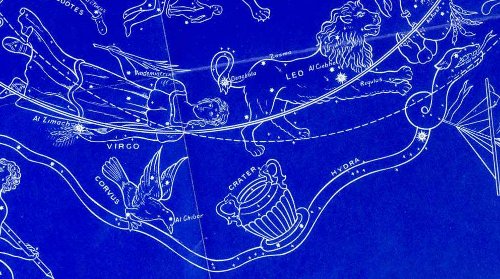 |
Why a raven for Joseph Smith? In folk tale symbolism, the raven often represents someone who has died and is bringing a message as a spirit. That matches what the Perseus myth says was required from Perseus to be able to slay the Medusa (invisibility). Thus, it is consistent with the symbolism that the Prophet would be martyred on Raven Day on the Hebrew Calendar.
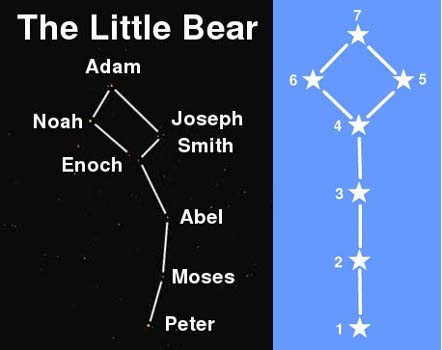 |
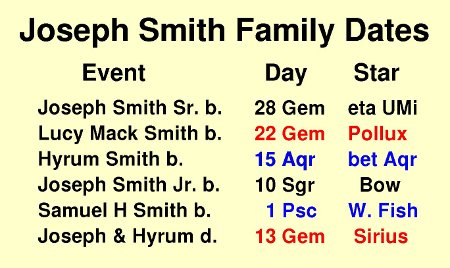 |
Another earlier article discussed the kite-shaped Priesthood Pattern of Seven and showed how each of seven leaders that are associated with a constellation can be easily identified by this pattern. It noted that there are seven constellations in this kite-shape and that the constellation that represents the highest group is the Little Bear.[10] If in fact those seven stars represent the seven chief angels, then Joseph Smith, the fifth angel, would be at position shown in Figure 5. It turns out that was the star day at the birth of Joseph Smith Sr., father of the Prophet, on both the Star Calendar and Uniform Star Calendar. For him to have been born on a star day representing his son on two calendars provide two more powerful witnesses of the Prophet Joseph.
Joseph's brothers Hyrum and Samuel were also born on holy days on the Star Calendar. And of course Hyrum was martyred on the same death date as the Prophet, on the day of Sirius, the brightest star in the sky.
Much has been said in my articles about events of the life of Jesus Christ on the sacred calendars. Indeed, the day of His Resurrection is holy on more sacred calendars than any other, for which reasons it has been called the "holiest day in history" in my articles. One article discusses how each of the 9 pairs of holy days on the Venus calendar are associated with a key event in His life. So what about the Star Calendar?
Let's begin with the day of the birth of Jesus Christ. On the Star Calendar the birth of Christ during the evening preceding Thu 6 Apr 1 BC occurred on the day 26 Ari, associated with the star ν Ari here named "Fleece" (short for "Golden Fleece"). It is star of average brightness up on the back of the Ram (Aries), who in mythology was the Ram with the Golden Fleece. That fleece was the object of the quest of Jason and all those on the ship Argo, which included many of the superheroes such as Hercules, Pollux and Castor. The fleece was said to be immortal and to give immortality to anyone who wore or possessed it. The fleece was hanging from an apple tree which was guarded by a dragon. It may have represented resurrection and eternal life. Religiously, the Ram apparently represents the Lamb of God grown to maturity.
 |
The date of the resurrection of Jesus Christ was not an obscure date, but was holy on nearly all of the sacred calendars known so far. It is no exception on the star calendars. It turns out that those two calendars were aligned for the three years of Christ's ministry, so every date in that interval was the same on both the Star Calendar and the Uniform Star Calendar. The star day for the Resurrection was the holy day 22 Ari, being that of the brightest star in the constellation. That day is holy both because it is on day 22 and also it is the star which represents the entire constellation and hence is called "the Ram" (Hamal, meaning "sheep"). That day was the equivalent of the Last Day of Passover on the Star Calendar, a major holy day.
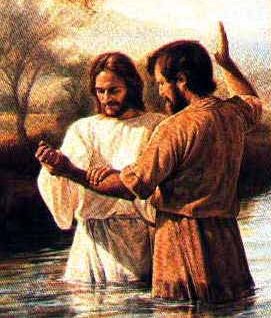 |
The day on which Jesus began his ministry was also the star day of the Ram, the same as the Resurrection. The ministry began on the afternoon of a Saturday and the Resurrection on the morning of a Sunday, but the star day runs from noon to noon, and it turns out both were on the same day of the star year.
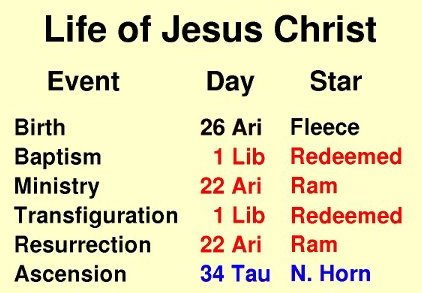 |
In earlier articles, many proposed dates of events in the lives of Biblical patriarchs and their wives have been published. If this Star Calendar is really used by the Lord for timing events in their lives, then there should be several matches that support what has been published. More than enough supporting evidence from the Star Calendar has indeed been found to merit its publication in this article. Those presented here are limited to those with two types of witnesses: (1) either two clear examples of the same pattern, or (2) one "bull's-eye" example of the star being in a position in the constellation that relates directly to the event. Let us now look at some examples.
As seen in the lives of those in the Prophet Joseph Smith's family, the Star Calendar seems to be used heavily in the birth and dates of prophets and key religious figures. It also seems to be used somewhat for sacred events in their lives. Let us now turn to the Old Testament for its witness. For simplicity, the dates of these events on our Gregorian Calendar will not always be given because they can be found on the Religious Chronology page of my website, along with the references to where that date was discussed. In all cases only previously published dates are used so they can be treated as independently derived, and hence permissible to verify this calendar.
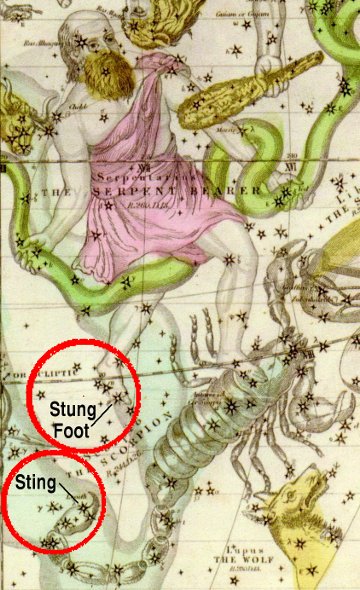 |
The very day proposed in my work many years ago for the death of Adam falls precisely on the day of the star theta Oph, which is hereafter called "Stung" in my work. It is a star of average brightness but which has been recognized since ancient times as important because it is very near the ecliptic and hence is useful as a marker. The ancient Babylonians used it to mark one of the "mansions of moon".
That is perfect symbolism for the death of Adam to have occurred exactly on the day of the star representing the heel stung by the Scorpion.
There is a second witness of this symbolism. In my articles it has been been pointed out that Adam's grandson Enos represented "mortality" (which word means "death"). For example, the name "Enos" means "mortal man" and the day 1 Skull on the Sacred Round was both the day of his birth and also of his death. Now we see that the day of the death of Enos also occurred on the day on the Star Calendar of lambda Sco (called Shaula meaning "Stinger"). It is a bright star and was well known in the ancient world as being located in the stinger of the Scorpion. Thus his death occurred on the one star in all of the sky that most represents death. Even with only these two examples, hopefully the reader is seeing the power of the witness of this calendar.
Another example from the life of Adam is that the day of his Fall occurred on the Star Calendar day of the star Spica (alpha Vir), one of the brightest stars in the sky, on the day 29 Vir. It represents the "Seed of Woman", being the grain seed in the hand of the Maiden (Virgo). It seems very fitting to have the promised Seed be associated with the Fall of Adam because the Seed Jesus Christ was destined to redeem mankind from that Fall.
 |
A confirmation that Cainan being born on the King star day is not due to chance is that he also died on the King star on the Uniform Star Calendar. That is beyond being a random occurrence.
Is there yet another example in my published chronology to verify that the association of the King star with this star day is meaningful and actually used by the Lord? Yes, there most definitely is. King David was also most famous for being king and also ruling with wisdom, as did his son Solomon. The Lord said that David was a man "after his own heart" (1 Sam. 13:14). The day proposed in my work for the birth of King David was also the day "King" (Regulus) on the Star Calendar.
Hopefully the reader sees that each of these witnesses serves to verify both the already published dates as well as the Star Calendar itself. Now let us look at a few examples from the family of Jacob, who was also called Israel.
Rather than try to look at birth and death dates all through the Old Testament, let's just look at some in the family of Jacob and his twelve sons. Even there, let's just look at examples with either two witnesses or with especially meaningful dates.
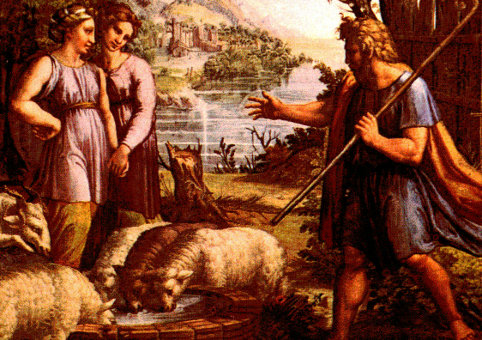 |
Now looking at the Star Calendar, it is seen that the first marriage (to Leah) occurred on the day 15 Tau, with the star being Alcyone, which represents the star cluster of the Seven Sisters (Pleiades). Then the marriage to Rachel occurred on 22 Tau, the star Aldebaran, the Seer. Of the entire year, that week corresponded to a stellar equivalent of Passover because it occurred in the spring (at that time). The reader should understand that due to the slow precession of the spinning earth (like a spinning top slowing down), the positions of the stars change relative to the seasons by about one constellation every 2,000 years. Thus, at the time of Joseph, the stellar Passover (in March-April) occurred in the Bull, at the time of Christ it was in the Ram, and currently it is the Fishes.
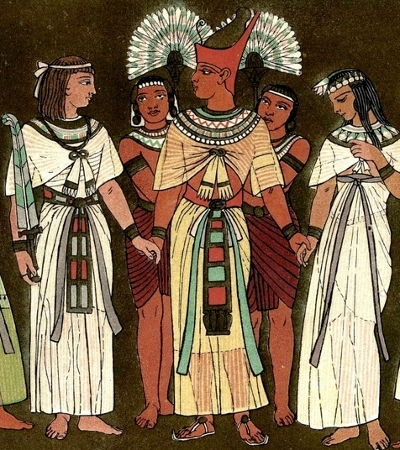 |
A confirmation of Levi's birth date is now found in his death date, which was also the day 1 Psc. Thus, he lived an exact number of sideral years, which is the year of 365.2564 days on which the Star Calendar is based ("sidereal" means "star").
Another confirmation of proposed birth dates of Jacob's sons is that both Joseph and his wife Asenath were born on the Star Calendar date 22 Tau, which is the bright star Aldebaran, the Seer. That is a perfect star for Joseph, who was a seer, and for his wife to be linked to him. It is also the star of Joseph Smith who would be his great descendant named after him.
Another perfect date is that of the birth of Benjamin who was born in the constellation of the Twins (Gemini). The two sons of Rachel, Joseph and Benjamin, are a pair that fit into the Twins pattern: a greater and a lesser, like the Big Dog and Little Dog. Benjamin was like the Little Dog. There is one bright star in the Little Dog: Procyon. Benjamin was born on the day of Procyon: 25 Gem. Those are the only two of the sons of Jacob born on a bright star day.
Several events of the Exodus occurred not only on sacred days on the Star Calendar, but also on days when the star matched the event.
The day the Ten Commandments were given occurred on 1 Cnc (first day of the Crab). The Crab represents the Deliverer. In this case it can represent both the Lord and Moses who would deliver Israel from the bondage of Egypt. Thus, the day seems fitting indeed.
The day of the Raising of the Tabernacle was a day which clearly represented the Resurrection, both in the obvious event itself of raising the body (tabernacle) and also on sacred calendar days. It came on the eighth day counting from the day of the anointing of the high priest Aaron. It occurred on the sacred day of 1 Jachin on the Priest Calendar, the same as on the day of the resurrection of Jesus Christ. Early Christians understood well the symbolism of the Christ rising on the eighth day of the week, which is Sunday, the same as the first day.
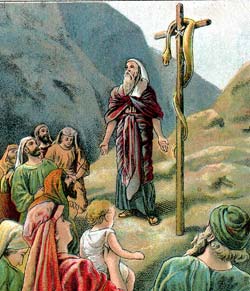 |
The day of the Brazen Serpent also fell on very meaningful sacred days on both star calendars. It occurred on the day 8 Lib on the Star Calendar, the day of beta Lib, the star in the left tray of the Balance (as seen by the Scorpion judge), which is the side which is high and wanting more weight to balance. In my work this star is called "Wanting" because it seems to refer to man who was weighed in the scales and found wanting (Dan. 5:27). Surely on that day many were found wanting and died from the snake bites.
 |
Another example of these two stars being used to help explain an event was at the time of the Great Deluge. On the Uniform Star Calendar, the day on which Noah loaded the ark occurred on the day Redeemed. Seven days later when the Flood began, the day was Wanting. That really seems to fit the first group being saved and the other being destroyed.
The date of the revelation of the book of Deuteronomy occurred on the day 22 Aqr, Fomalhaut, the bright star in the head of the Southern Fish (Piscis Austrinus) which is one of the "four corners of the earth". Being found in the head, it is representative of teaching and intelligence. It is also found at the end of the stream of the righteous of Aquarius. That constellation symbolizes Christ as the Master (teacher), pouring out blessings on the head of his church. Thus it was a perfectly suited day on which to reveal the teachings of Deuteronomy.
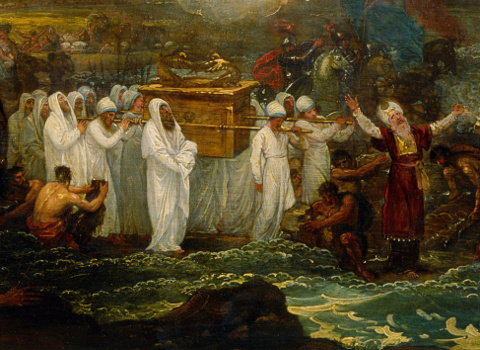 |
Let us now look at the timing on the Star Calendar of some key events in the early history of The Church of Jesus Christ of Latter-day Saints (LDS). We've already seen how the stars witness of the role of the Prophet Joseph Smith, including even calendar links to his parents. Now let's focus on events of the early Church itself in his day.
Although the exact date of the First Vision of the Prophet Joseph Smith was apparently not recorded, it has been proposed in my work that it occurred on the morning of Sun 26 Mar 1820. That date was indicated because it marked the first day of a 364-year era on the Enoch Calendar. Later it was discovered to have also started one of the ten periods of 728 years of Enoch's prophecy of Weeks.[11] Now two more stunning witnesses from the stars strongly confirm that date.
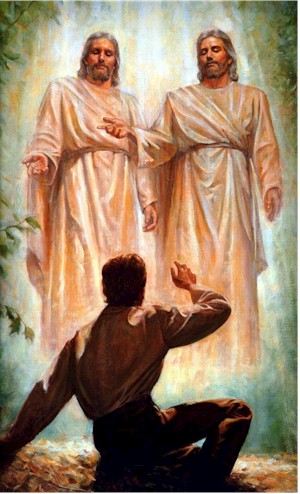 |
This date provides a perfect example of how the Uniform Star Calendar can provide additional information about an event. The day of the First Vision on that calendar was that of the bright star Aldebaran, alpha Tau, the Seer, on the day 22 Tau. As already herein discussed, that star represents Joseph Smith, one of the greatest seers of all time.
How appropriate for the First Vision to have taken place on a day appropriate for heavenly visitations on one star calendar and also the very day of Joseph the Seer on the other!
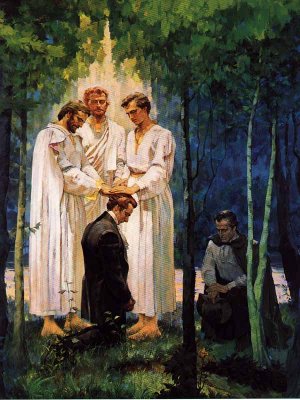 |
The date proposed in my work for the restoration of the Aaronic Priesthood in May 1829 falls on the Star Calendar date of 8 Tau, with the star being tau Per, the star at the head of the hero Perseus. That star is used to represent the entire constellation and is called "Hero" in my work. As reviewed above, the myth of Perseus seems to be describing the Prophet Joseph Smith and his receiving various gifts from divine messengers. That day was when the resurrected divine messenger John the Baptist bestowed the Aaronic priesthood on him. How appropriate for it to occur on a day representing Joseph Smith!
The proposed date of the restoration by Peter, James and John of the priesthood needed for the elders of the Church occurred just two weeks later on the day 22 Tau. As already discussed, that is the day of the star Seer (Aldebaran), which is the star best representing Joseph the Seer. Again, that event is explicitly mentioned in the myth where the Swan Women provide the eye for Perseus to use to see. The Swan (Cygnus) is a constellation representing Peter, so it appears that the three women sages represented Peter, James and John. Again, the day is a perfect fit!
The office of high priest in the Church, which requires a higher level of Melchizedek priesthood than does elder, was restored on the day 29 Tau (Sat 4 Jun 1831), which corresponds to the star beta Ori, Rigel, the brightest star in Orion. Orion symbolizes Adam and also Jesus Christ who have all the highest levels of priesthood. The day 29 Tau suggests a progression after 22 Tau, and indeed this was the day when elders were first ordained to be high priests.
Thus, all three dates of priesthood restorations fit a very simple pattern, with the first two occurring on days which represent the Prophet Joseph himself. It sure does appear to be according to precise clockwork.
 |
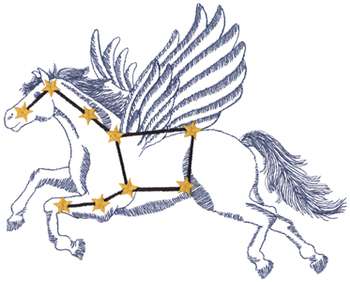 |
One feature of the pair of dates has always been a puzzle to me. Being a week apart, they seemed as though they should be the first and last days of some sort of Passover celebration. Many events took place similar to the last week of the Savior's life, such as having the sacrament and the ordinance of the washing of the feet. Yet, those seven days did not correspond to any Passover week on any calendar known to me. Passover on both the Hebrew and Enoch calendars began on Sat 2 Apr 1836, not the previous week. That has remained a mystery until now.
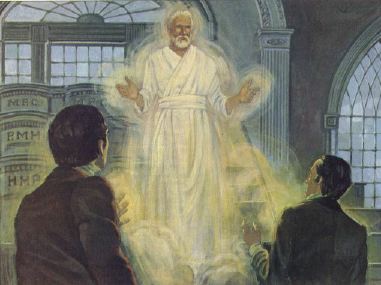 |
A week later there was an extremely important visitation in that temple. The Savior, Moses, Elias, and Elijah all appeared to the Prophet Joseph Smith and Oliver Cowdery. Important priesthood keys were restored. The most famous were the last restored by Elijah, who "revealed the priesthood" (JSH 1:38) to them. Elijah was commissioned to "plant in the hearts of the children the promises made to the fathers" (JSH 1:39). This mission of Elijah had everything to do with connecting fathers and children. It appears that what was restored was the power to seal the children to the fathers, especially into the covenant line of Abraham, Isaac, Jacob, and Joseph.
The day on which Elijah returned was 22 Psc, the Last Day of the week of the star Passover. It is also represented by a star in Pegasus.[14] The Greeks said it was located at the navel of the horse. The name of the star is Alpheratz which is from the Arabic for "Horse's Navel". That location of the star is near the reproductive area and may have everything to do with offspring. With that understanding, that star is a perfect one to have on the day on which Elijah, who ascended to heaven in a chariot of fire, returned to restore covenant power of the fathers and the authority to seal the children to their fathers. A possible name for this star in this context is "Sire". Figure 6 shows the positions of both the star in the wing and at the navel.
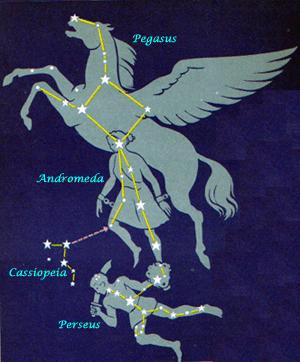 |
Combining those two positions in different constellations of that star seems to imply that this was the day that the power to seal children to the fathers was bestowed upon the head of the Lord's Church. That seems amazing that a star shared by two constellations would have the meaning of both of them be so relevant on the very day that Elijah returned with that very mission on the very day of that very star!
The Star Calendar was introduced with an explanation of how it associates every day with a star. Evidence was produced implying that the Lord is using this calendar for the timing of key events in the life of the Savior and of his servants. Detailed examples were provided for the life of the Prophet Joseph Smith strongly supporting the conclusion from earlier articles that he is one of the seven chief angels of God. In those articles it was proposed that several constellations symbolize him, such as the Big Dog and Pollux (one of the Twins). This article confirms that by showing that events of his life occurred on Star Calendar dates associated with stars from those very constellations. Similarly, many previously published dates in a chronology back to Adam were also confirmed in the same manner.
Truly the intelligence of the Creator is astounding to behold. There are so many levels of heavenly testimony of his servants and their great works. Our solar system and its placement among the stars was carefully chosen by an all knowing Creator. Truly the heavens declare the glory of God!